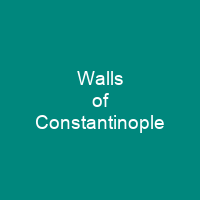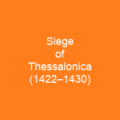The Walls of Constantinople are a series of defensive stone walls that have surrounded and protected the city of Constantinople since its founding. Initially built by Constantine the Great, the walls surrounded the new city on all sides, protecting it against attack from both sea and land. They saved the city, and the Byzantine Empire with it, during sieges by the Avar-Sassanian coalition, Arabs, Rus’, and Bulgars. Ultimately, the city fell from the sheer weight of numbers of the Ottoman forces on 29 May 1453 after a six-week siege.
About Walls of Constantinople in brief
 The Walls of Constantinople are a series of defensive stone walls that have surrounded and protected the city of Constantinople since its founding. Initially built by Constantine the Great, the walls surrounded the new city on all sides, protecting it against attack from both sea and land. They saved the city, and the Byzantine Empire with it, during sieges by the Avar-Sassanian coalition, Arabs, Rus’, and Bulgars, among others. Ultimately, the city fell from the sheer weight of numbers of the Ottoman forces on 29 May 1453 after a six-week siege. Despite lack of maintenance, many parts of the walls survived and are still standing today. A large-scale restoration program has been underway since the 1980s. The walls were largely maintained intact during the Ottoman period until sections began to be dismantled in the 19th century, as the city outgrew its medieval boundaries. The wall was protected by 27 towers and had at least two landward gates, one which survived to become known as the Arch of Urbicius, and one where the Milion monument was later located. On the seaward side, the wall was much lower. A wall is known to have been repaired, using tombstones, under the leadership of a certain Leo in 340 BC, against an attack by Philip II of Macedon. The Severan Wall is located at the end of its main avenue. Little is known of its course save for a short description of its gate was located by Zosimus and shortly before the entrance of the Forum of Constantine.
The Walls of Constantinople are a series of defensive stone walls that have surrounded and protected the city of Constantinople since its founding. Initially built by Constantine the Great, the walls surrounded the new city on all sides, protecting it against attack from both sea and land. They saved the city, and the Byzantine Empire with it, during sieges by the Avar-Sassanian coalition, Arabs, Rus’, and Bulgars, among others. Ultimately, the city fell from the sheer weight of numbers of the Ottoman forces on 29 May 1453 after a six-week siege. Despite lack of maintenance, many parts of the walls survived and are still standing today. A large-scale restoration program has been underway since the 1980s. The walls were largely maintained intact during the Ottoman period until sections began to be dismantled in the 19th century, as the city outgrew its medieval boundaries. The wall was protected by 27 towers and had at least two landward gates, one which survived to become known as the Arch of Urbicius, and one where the Milion monument was later located. On the seaward side, the wall was much lower. A wall is known to have been repaired, using tombstones, under the leadership of a certain Leo in 340 BC, against an attack by Philip II of Macedon. The Severan Wall is located at the end of its main avenue. Little is known of its course save for a short description of its gate was located by Zosimus and shortly before the entrance of the Forum of Constantine.
The modern wall seems to have extended from near the Eminönata Bridge in the south through the vicinity of the Nuruosmani Mosque to curve around the southern wall of the Hippodrome, then going northeast to meet the old walls near the Bosporus. The Patria of Constantinople also mention the existence of another wall located near the middle of the Philadephiion, located about the corner of the modern Galatasaray. The city was founded as Byzantium by Greek colonists from Megara, led by the eponymous Byzas, around 658 BC. At the time the city consisted of a small region around an acropolis located on the easternmost hill. According to Cassius Dio, the city held out against Severan forces for three years, until 196, with its inhabitants resorting even to throwing bronze statues at the besiegers when they ran out of other projectiles. In 479 BC, the Spartan general Pausanias, who conquered the city in 479BC, rebuilt the city. However, appreciating the city’s strategic importance, Septimius Severus eventually rebuilt it and endowed it with many monuments, including the Baths of Zeuxippus, as well as a new set of walls, located some 300–400 m to the west of the old ones. This wall is believed to have dated to the time of Byzantine times, but it is more likely that it reflects the situation after the city was rebuilt.
You want to know more about Walls of Constantinople?
This page is based on the article Walls of Constantinople published in Wikipedia (as of Nov. 07, 2020) and was automatically summarized using artificial intelligence.







